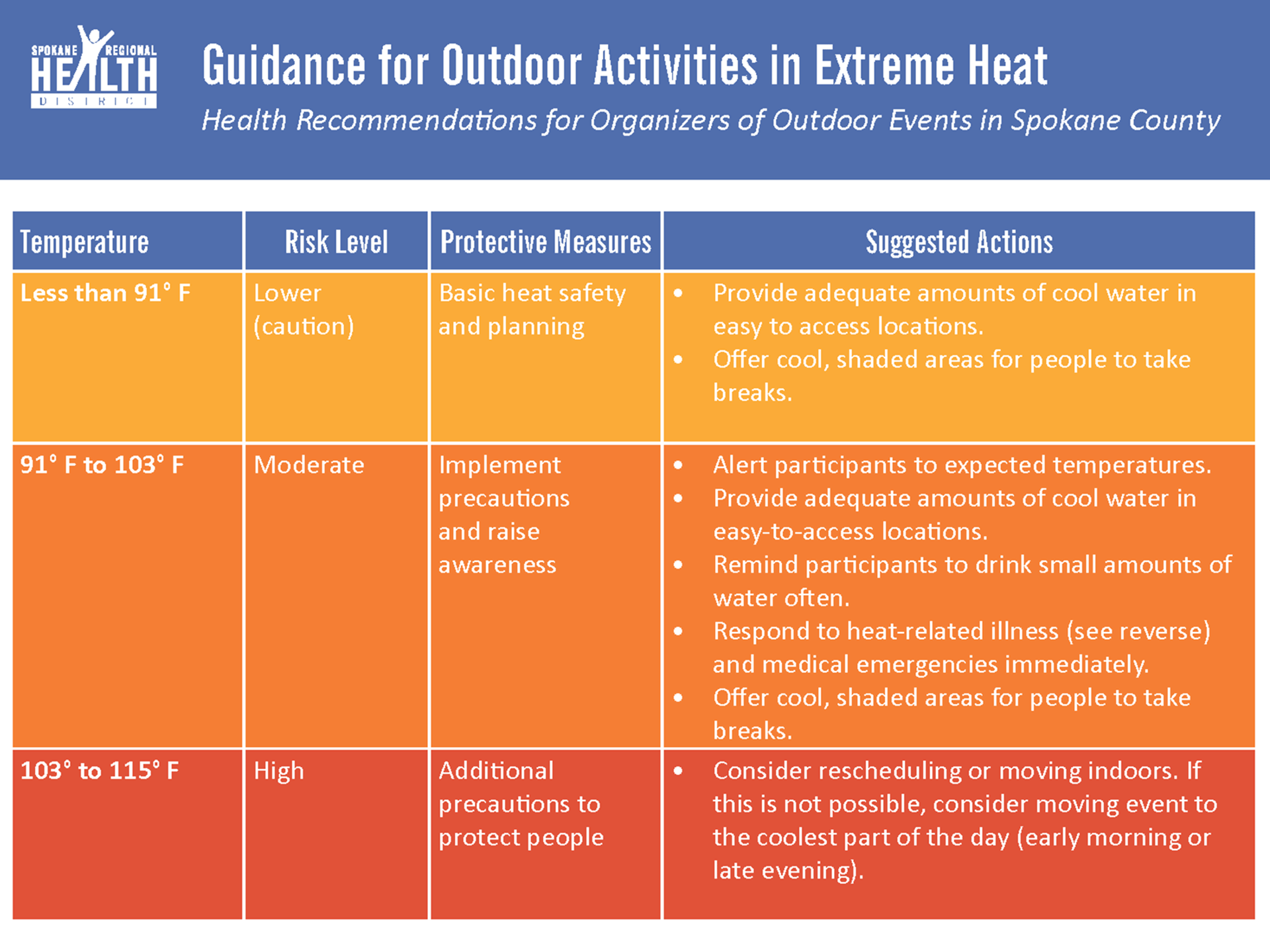Severe Weather
Extreme Heat
Extreme heat is defined as a period of excessively hot weather, with higher than average temperatures for a particular region, combined with high humidity. Extreme heat events can happen anywhere in the United States, and commonly occurs in the summer. In the Spokane region, the hottest time of the year is from June to September, with July and August seeing the highest annual average temperatures.1
Extreme Heat Safety Tips2
- Stay indoors, especially during the warmest part of the day (11 a.m. - 2 p.m.) and stay in a cool or air-conditioned place.
- Wear lightweight, light-colored, loose-fitting clothing.
- If you must be outside, wear a hat, sunglasses and put on sunscreen of SPF 30+, preferably with mineral sunscreen instead of chemical sunscreen.
- Avoid strenuous activity. If you must work, take frequent breaks.
- NEVER leave humans or animals in a parked vehicle if the air conditioning (A/C) is not functioning properly and is not on high.
- Some people are at greater risk for heat related illness than others. Check regularly on: infants/young children, people aged 65+, People who have a mental illness, those who are physically ill, especially with heart disease or high blood pressure.
- Get to know symptoms for heat stroke, heat exhaustion, heat cramps and sunburn and how to respond immediately.
For more information on extreme heat, visit: https://www.ready.gov/heat, SRHD's Extreme Heat Page.

Winter Storms
Winter storms can range from a normal snow over a few hours to a blizzard with blinding, wind-driven snow lasting for several days. Many winter storms bring dangerously low temperatures and sometimes, strong winds, ice, sleet, and freezing rain. One of the main concerns is that winter weather can knock out heat, power, and communication, sometimes for days at a time. Heavy snowfall and extreme cold can have serious effects on an entire region. Icy roadways can cause serious accidents, and sometimes people die from being in really cold temperatures for too long.3
Safety Tips During Severe Winter Weather:
- Stay indoors and off the roads. If you must drive, keep emergency supplies in your car.
- Close off rooms to consolidate and retain heat.
- Dress in layers and use blankets to stay warm.
- Bring pets into a warm place and out of the storm or severe cold.
- NEVER use a generator, camp stove, charcoal grill, or gasoline or propane heater indoors, as these items can start accidental fires, cause electric shock, and/or cause deadly carbon monoxide poisoning.
- NEVER heat a home with a cooktop or oven.
For more information on winter storms visit: https://www.ready.gov/winter-weather, visit the Spokane Regional Health District's webpage for extreme cold preparedness.
Thunderstorms
All thunderstorms are dangerous because every thunderstorm produces lightning, which can kill or seriously hurt people. Thunderstorms are also dangerous because they can lead to flash floods. Thunderstorms and lightning happen everywhere, but dry thunderstorms that don’t produce rain are most common in the Western U.S.
Facts About Thunderstorms
- Some of the most severe storms occur when a single thunderstorm affects one location for an extended time.
- Thunderstorms typically produce heavy rain for a brief period, anywhere from 30 minutes to an hour.
- Warm, humid conditions are highly favorable for thunderstorms to develop.
- About 10% of thunderstorms are classified as severe—one that produces hail at least 3/4 of an inch in diameter, has winds of 58 MPH+, or produces a tornado.
Facts About Lightning
- Lightning's unpredictability increases the risk to individuals and property.
- Lightning often strikes outside of heavy rain and may occur as far as 10 miles away from any rainfall.
- "Heat lightning" is actually lightning from a thunderstorm too far away for thunder to be heard. However, the storm may be moving in your direction!
- Most lightning deaths and injuries occur when people are caught outdoors in the summer months during the afternoon and evening.
- Lightning-strike victims carry no electrical charge and should be attended to immediately.4
Thunderstorm & Lightning Safety Tips
- NO PLACE outside is safe when thunderstorms are in the area.
- If you hear thunder, lightning is close enough to strike you.
- When you hear thunder, immediately move to safe shelter: a building with electricity or plumbing or an enclosed, metal-topped vehicle with windows up.
- Stay in safe shelter at least 30 minutes after you hear the last sound of thunder.5
- If you are caught in an open area, crouch down in a ball-like position with your head tucked and hands over your ears so that you are down low with minimal contact with the ground.
- If you are in a group, separate from each other. This will reduce the number of injuries if lightning strikes the ground.
- Avoid open vehicles (convertibles, motorcycles, golf carts).
- Avoid open structures (porches, gazebos, baseball dugouts, and sports arenas).
- Stay away from open spaces such as golf courses, parks, playgrounds, ponds, lakes, swimming pools, and beaches.6.
For more information on thunderstorms and lightning, visit: https://www.ready.gov/thunderstorms-lightning.
1 Source: https://www.usclimatedata.com/climate/spokane/washington/united-states/uswa0422
5 Source: https://www.weather.gov/safety/lightning-tips
6 Source: https://www.cdc.gov/disasters/lightning/safetytips.html
Contact Us
If you have questions or comments, please contact:
Sarah Nuss
Director of Emergency Management, City of Spokane
snuss@spokanecity.org
